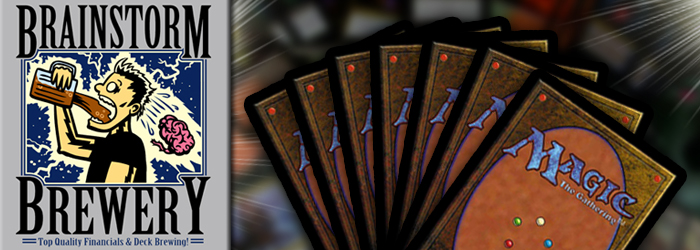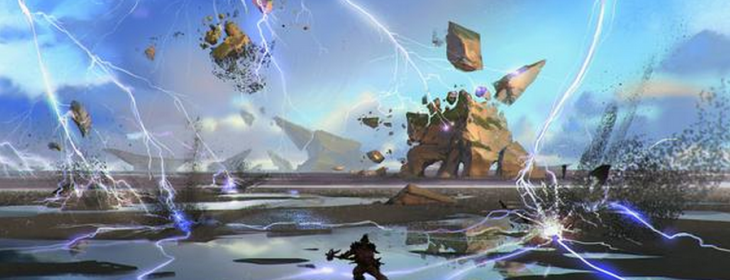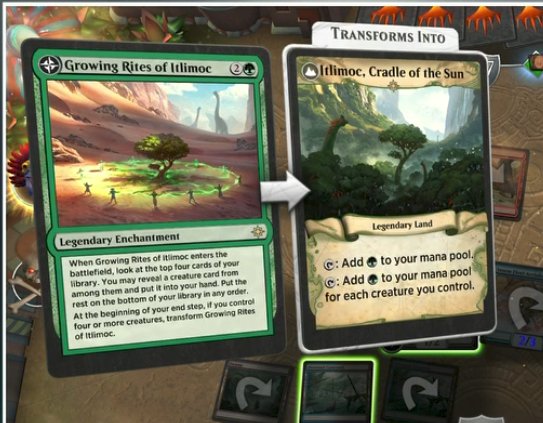Last week was a nice break from the norm, wasn’t it? I enjoyed it so much that I think this week we’re going to take a break from the norm. Whereas last week we were concerned with Explorers of Ixalan (a great idea and a great avenue for reprints and if you buy this and play with it, give yourself a wedgie) and how this could affect not only the prices of the cards printed in it but how it could impact future confidence in our picks for the role of “this will go way up if it’s not in the Commander set” like we saw this year with cards like Patriarch’s Bidding, Cover of Darkness and Mana Echoes.
I noticed something else worth talking about this week, and it ties in a bit with a question a Brainstorm Brewery listener asked on the podcast this week. If you’re reading this on Thursday, the episode will be out tomorrow.
What Was The Question?
A listener (I don’t remember who but I sort of feel like I should because I remember recognizing the name and now I feel kind of bad but only to the extent that it’s on brand for me to care about stuff like that, which is to say “not much”) asked about the limitations of using EDHREC as a metric for speculation targets. Wouldn’t the decklists seem to skew toward older cards? Would new cards that affected older archetypes even be counted since people aren’t likely to re-register their deck just because one new card was printed? In short, aren’t we missing a bunch of stuff?
What Was My Response?
At first I barely wanted to answer the question. It’s a mixed bag of things we’ve addressed, things that don’t matter and things that are impossible to quantify. The point most worth going into, that people aren’t going to re-register their decks just because of a new card being printed. That’s a huge blind spot for EDHREC. If our premise that new cards affect the prices of older cards, how will we ever know that? It’s a gigantic flaw in my model of using EDHREC to try and predict coming price spikes.
I think that would be a gigantic flaw if that were true. I think, though, that we’re seeing the opposite. I also think that’s not a problem.
Why Wouldn’t It Be A Problem?
Well, if we are not going to get people registering new lists for old decks predicated on new cards, we’re going to miss cards. Missing cards sucks, but it happens. Missing a spec feels bad and that’s about it. You’re not harmed by missing a spec. You didn’t get to make money but you didn’t lose any actual money. If people are looking at Growing Rites of Itlimoc and deciding that they’re going to update their Meren of Clan Nel Toth deck. So? They’re not building a brand new deck so they’re not going to move the prices on any other cards. If they build a new deck, they’ll buy new cards and that means they’re more likely to register a new list on one of the sites EDHREC scrapes and we’ll see movement. So either something happens and we don’t notice it unless we notice it a different way, or something happens that we’ll notice or nothing happens. All of this is fine.
Is The Opposite A Problem?
If someone decides that Growing Rites of Itlimoc means they want to update their Meren deck and they make a new list, or update the old list on a site that re-registers the original deck and the update as two decks on EDHREC, or if EDHREC is just garbage at accounting for that (that’s something I don’t know and should maybe look into), then it’s possible we’ll get false positives. False positives are actually probably bad. Missing a spec feels bad but buying a busted spec IS bad AND feels bad. You’re out actual money, not theoretical money, and while getting nipped by fees when you buy and when you sell is usually OK on a good spec since that just takes a tiny nip out of your profit sammich, getting slapped in the ass coming and going on a busted spec that you end up putting in a box of shame forever or buylisting or forgetting about is worse. Buying a card that never goes up because you saw a signal that was really just noise is bad. I think the opposite of the bias our listener (I mean, based on how I interpreted the question he asked – he could have been asking about this and not the opposite and I just didn’t get it) was asking about is potentially a problem, but it’s not really a huge one. Even if people aren’t building more Meren decks, them registering new lists can put Meren back on the front page and that gets eyeballs on Meren. Some of the noise develops into signal just based on visibility. Can I quantify that effect? I mean, no, but that’s not anything that’s plagued us.
It’s not as though we’ve been whiffing when we base our specs on what people are registering. Wheels are in a bunch of The Locust God decks, wheels went up. Stuff like Morphling and Hateflayer are in Mairsil decks, they went up. EDHREC is probably bad at two things.
- Cards under like 18 months to 2 years old that could go up based on new decks
- Weeding out fake lists, or placeholder lists, or duplicate lists of the same deck (I mean, maybe. I don’t know for sure).
I think we’re probably OK with both of those things.
What Our Model Is Good At
By “our model” I don’t necessarily mean EDHREC’s because while I contribute in some modest capacity to the site, I don’t do any of the coding because nobody wants that. “Our model” refers to the one we have adopted for this series, namely that we see what people are building when a new commander comes out, or when a new card significantly shakes up old archetypes. That second one is more rare – we’re talking Panharmonicon, Paradox Engine, Anointed Procession-tier non-general cards.
The Gitrog Monster comes out and I say “I bet Squandered Resources goes up” because I understand EDH pretty well and I feel like every other speculation model I developed relied either one waiting for published decklists from tournaments which made us buy at the same time as everyone else or trying to stay ahead of formats I would have had to understand better than pro players to speculate in/on. Since I’m one guy, I usually nail a few cards because this is what I think about all day long while you think about how handy it is not to have to think about that stuff. Then, I check EDHREC and holy $%#&, I guess one guy isn’t ever as good as every guy and gal because I notice that Constant Mists, Groundskeeper (get foils), Life From the Loam and lots of other cards are impacted. This is hypothetical by the way, I remember knowing Constant Mists and Life From the Loam would go up, I just don’t remember which cards I only got because I saw them on EDHREC and this is a hypothetical example. The point is, a new deck is like a bunch of blind people trying to describe an elephant based on just the part they’re touching or whatever that dumb example they used to use in Six Sigma meetings. No one person gets the full picture but EDHREC crowdsources for us.
What Are We Seeing This Week?
I’m glad I pretended you asked. I might have written about a topic kind of like this based on that podcast listener question because I felt like it was too much material for the episode and I told the guy “I write about this, just go read my articles” and now there’s something that specifically addresses his points, as I understood them.
It was equally likely that I would have just found a popular commander and done a normal article based on that. Instead, I found something curious.

Meren? Shu Yun? The Scarab God is less curious considering it’s tearing up Standard. Kaalia just got a bunch of new Dragons. Atraxa is always popular. But Meren and Shu Yun?

Yisan? Is this because he was just unbanned in 1V1? Do we even scrape those lists or did a bunch of people mis-register? Ezuri? Hapatra? Why are older cards showing up in the most popular decks of the week but not the month? What happened recently that didn’t happen a month ago? Oh, I don’t know, maybe players getting their hands on cards from Ixalan. Let’s click on Yisan.

This is the only new card. That’s curious. What’s also curious is the text underneath that you may have missed or failed to interpret. It says “100% of 10 decks” which doesn’t mean 10 people ever have registered a Yisan, the Wanderer Bard deck. It means that of the 10 decks registered since Ixalan cards were tagged in the database, all of them play this card. That means 10 people made new decklists. Is this people with existing decks making a new list to incorporate Rites? Is it people making new decks? We don’t know, and that’s the problem my listener had with using EDHREC as a metric. Here’s where I’m going to get infuriating.
I don’t think it matters.
We use EDHREC deck inclusion numbers as a ratio, basically. We can say that the demand for a card that went up is half of what it is for another card and predict that other card will go up and we’re almost always right. We can use inclusion numbers to establish arbitrary thresholds below which we don’t think that the demand can soak supply. If the numbers don’t need to be absolute numbers, and they don’t, then it doesn’t matter if 10 people made a duplicate deck based on one new card or made new decks. It’s not going to shift the numbers enough to throw off our ratios. We’re not going to make bad decisions based on 10 decks. We’re not going to speculate on Growing Rites under any circumstances because the card is new and we like new archetypes to push up old cards with low supply and high growth potential.
Compare the 100% inclusion of Rites in the Yisan deck with the numbers we got for the only new card in the Meren decks.

Totes different. Meren is just getting built a lot because it’s in the Top 3 decks of all time and lots of people want to build it. Rites helps, but in fewer than half of the new decks.
It doesn’t take much drilling down to figure out what means new decks are getting made and what means decks are getting updated. I think I’ve managed to establish that my methodology for selection is sound and if we continue to let new archetypes identify older cards for us like we have been, we’re going to be able to continue to use EDHREC despite any limitations it might have (since we’re using EDHREC not at ALL the way it was intended to be used, so the fact that we are getting any usable data is pretty lucky).
I’ll now presume you’re all on board still/again/for the first time and use my last little bit of word count to use our old method to try and identify stuff with upside based on people building the 6th-most popular deck of the week, The Scarab God.

Scaraby got lots of new toys. The cool thing about the intersection of Commander 2017 and Ixalan is that while it was predicated on giving us strong Vampires with lots of overlap to make Standard players care about EDH and vice versa, there is a lot of “splash damage” and unintended tribes are getting sick goodies. Zombies got a tribal banner, a non-zombie that nonetheless swipes stuff so well we do it in Standard alongside Scaraby-face, a card that makes all of your cards zombies no matter what and the second tribe-matters land that taps for multiple colors in literally two sets. No wonder people are back to building Scarab decks.
Rooftop Storm – Is the first card I want to talk about. Ric Amundson wrote an EDHREC article about using Zur to grab Arcane Adaptation to make every creature in your deck a Zombie to make Rooftop Storm ridiculous. I think that’s cute, but since we’re playing Adaptation and Zombies, Rooftop Storm features heavily. I think the reprint risk of this card is pretty high and I might grab foils, as lazy as that seems to me since they’re harder to move and harder to buy large quantities of. Luckily the price isn’t that high so there’s no huge impetus to reprint other than “it might work in this goofy precon” although they may stay away from Zombies for a while. I like this pickup more and more as people build old tribes and Zombies continues to be one of the most popular.
Phenax, God of Deception – Everyone is holding their breath on the Gods after the reprinting of… the Boros one (I am bad with names) in a precon last year. They’ll reprint Thassa for EDH before they reprint Phenax. In fact, where DO they want to reprint a dedicated Mill God? He’s awkward in any product you put him in and that mitigates his reprint risk so much that I’m in below $10 on this guy.
Door of Destinies – This is another card I think they’ll leave alone for a while. With no dedicated tribal stuff coming in the forseeable future (except for when they bring core set back, I guess), you have a while for these to grow. But at the floor and get out as quickly as you can even if you leave some money for the next guy. These are risky long-medium-term but super juicy in the short term.
That’s all for me this week. I’m sorry for the wall of text. If this was boring, I’ll remind you that it’s sometimes important for me to defend the fundamental thesis of my entire series occasionally lest all of my advice be suspect all at once. I think we’ve developed a pretty good track record using the new method and I think weaknesses in the model don’t matter. If you think they matter or I missed something, let’s argue in the comments section. Thanks for reading. Until next time!



















